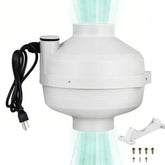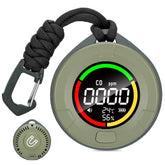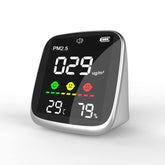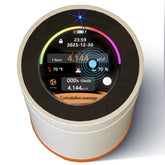How to Test Air Quality in Your Home?
Indoor air quality (IAQ) is a critical factor that directly impacts your health, comfort, and overall well-being. With most people spending a significant amount of time indoors, ensuring that the air in your home is clean and safe is essential. Poor air quality can lead to a range of health issues, from minor irritations to severe respiratory problems. In this blog, we’ll explore how to test air quality in your home, identify common pollutants, and provide actionable steps to improve and maintain a healthy living environment.
Importance of Indoor Air Quality
Indoor air quality refers to the condition of the air within and around your home. Unlike outdoor air, which is constantly circulated, indoor air can become stagnant and polluted over time. Poor IAQ can lead to health problems, especially for vulnerable groups like children, the elderly, and individuals with pre-existing conditions.
Common Indoor Air Pollutants
Indoor air can be contaminated by a variety of pollutants, including:
-
Particulate Matter (PM2.5 and PM10): Tiny particles from dust, smoke, and pollen.
-
Volatile Organic Compounds (VOCs): Chemicals emitted from paints, cleaners, and furniture.
-
Carbon Monoxide (CO) and Carbon Dioxide (CO2): Gases from combustion appliances and poor ventilation.
-
Radon: A naturally occurring radioactive gas.
-
Mold Spores: Fungi that thrive in damp environments.
-
Allergens: Pollen, pet dander, and dust mites.
Health Impacts of Poor Air Quality
Exposure to poor indoor air quality can cause:
-
Headaches, dizziness, and fatigue.
-
Allergies and respiratory issues like asthma.
-
Long-term health risks, including heart disease and lung cancer.
Signs of Poor Air Quality
A. Physical Symptoms
If you or your family members experience frequent headaches, allergies, or respiratory issues, it could be a sign of poor air quality.
B. Odors and Stuffy Air
Persistent odors or a stuffy, stale feeling in your home often indicate inadequate ventilation or the presence of pollutants.
C. Visible Mold or Dust Accumulation
Mold growth or excessive dust buildup are clear indicators of air quality issues that need immediate attention.
Methods to Test Air Quality
A. DIY Testing Kits
-
Types of Kits: Available for testing mold, radon, VOCs, and more.
-
How to Use Them: Follow the instructions provided with the kit to collect air samples.
-
Pros and Cons: Affordable and easy to use, but may lack the accuracy of professional testing.
B. Air Quality Monitors
-
Features to Look For: Choose monitors that measure PM2.5, CO2, VOCs, and humidity.
-
Popular Brands and Models: Brands like Awair, Airthings, and Temtop offer reliable devices.
-
How to Interpret Results: Compare readings to EPA guidelines to determine if your air quality is within safe limits.
C. Professional Testing
-
When to Hire a Professional: If you suspect serious issues like radon or mold, or if DIY tests show concerning results.
-
What to Expect: Professionals use advanced equipment to assess air quality and identify pollutants.
-
Cost Considerations: Prices vary depending on the scope of testing, but it’s a worthwhile investment for accurate results.
Key Pollutants to Test For
A. Particulate Matter (PM2.5 and PM10)
These tiny particles can penetrate deep into the lungs and cause respiratory and cardiovascular issues.
B. Volatile Organic Compounds (VOCs)
VOCs are emitted by household products and can cause headaches, nausea, and long-term health effects.
C. Carbon Monoxide (CO) and Carbon Dioxide (CO2)
High levels of CO can be deadly, while elevated CO2 levels indicate poor ventilation.
D. Radon
A colorless, odorless gas that is the second leading cause of lung cancer.
E. Mold Spores
Mold can trigger allergies and respiratory problems, especially in damp environments.
F. Allergens
Pollen, pet dander, and dust mites are common triggers for allergies and asthma.
Steps to Improve Air Quality
A. Ventilation
-
Opening Windows: Allow fresh air to circulate and reduce pollutant buildup.
-
Using Exhaust Fans: Install fans in kitchens and bathrooms to remove moisture and odors.
B. Air Purifiers
-
Types of Air Purifiers: HEPA filters for particulates, activated carbon for odors and VOCs.
-
Choosing the Right One: Select a purifier based on your specific needs and room size.
C. Humidity Control
-
Ideal Humidity Levels: Maintain humidity between 30-50% to prevent mold growth.
-
Using Dehumidifiers or Humidifiers: Adjust humidity levels as needed.
D. Regular Cleaning
-
Vacuuming and Dusting: Use a vacuum with a HEPA filter to trap dust and allergens.
-
Cleaning HVAC Systems: Replace filters and clean ducts regularly.
E. Reducing Sources of Pollution
-
Avoiding Smoking Indoors: Tobacco smoke is a major indoor pollutant.
-
Using Low-VOC Products: Choose paints, cleaners, and furniture with low chemical emissions.
Preventive Measures
A. Regular Maintenance of HVAC Systems
Schedule annual inspections and cleanings to ensure your heating and cooling systems are functioning efficiently.
B. Using Houseplants to Improve Air Quality
Plants like spider plants and peace lilies can naturally filter the air, though they should not replace other measures.
C. Avoiding Synthetic Air Fresheners and Candles
Opt for natural alternatives like essential oils or beeswax candles to avoid introducing harmful chemicals into your home.
Testing and improving your home’s air quality is a vital step toward creating a healthier living environment. By using DIY kits, air quality monitors, or professional services, you can identify and address pollutants effectively. Regular monitoring, proper ventilation, and preventive measures will ensure that your indoor air remains clean and safe for you and your family. Take action today to breathe easier and live healthier!
By following this guide, you can take control of your home’s air quality and create a safer, more comfortable environment for everyone. Don’t wait—start testing and improving your indoor air today!









Leave a comment
All blog comments are checked prior to publishing